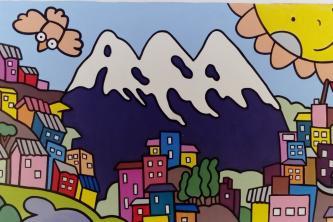
19 June 2017
Moving towards the city center, one discovers the “chaos” that reigns in the streets: vehicle congestion and traffic mayhem give rise to constant tension and turmoil among users of the public space. Pedestrians attempting to cross the street must face the rage of drivers who dominate the roads. Between walking (a risky endeavor in this hostile environment) and taking a minibus (which are constantly delayed by traffic), the choice proves difficult. But at the corner of an intersection one catches a glimpse of a white and black striped figure dancing, jumping...A zebra.

The city of Nuestra Senora de la Paz (Our Lady of the Peace) is the seat of Bolivia’s central government. Created by Spanish colonists in October 1548, it is a landmark between the large colonial cities of Cuzco in Peru and Potosi in Bolivia. Located at the foot of the Illimani at 3625 meters, La Paz is one of the world’s highest cities. Characterized by its network of valleys and rivers, the country spans 3021 km². Today, La Paz is a “modern,” dynamic city of almost a million inhabitants, 75% of whom describe themselves as content (Arroyo 2016).
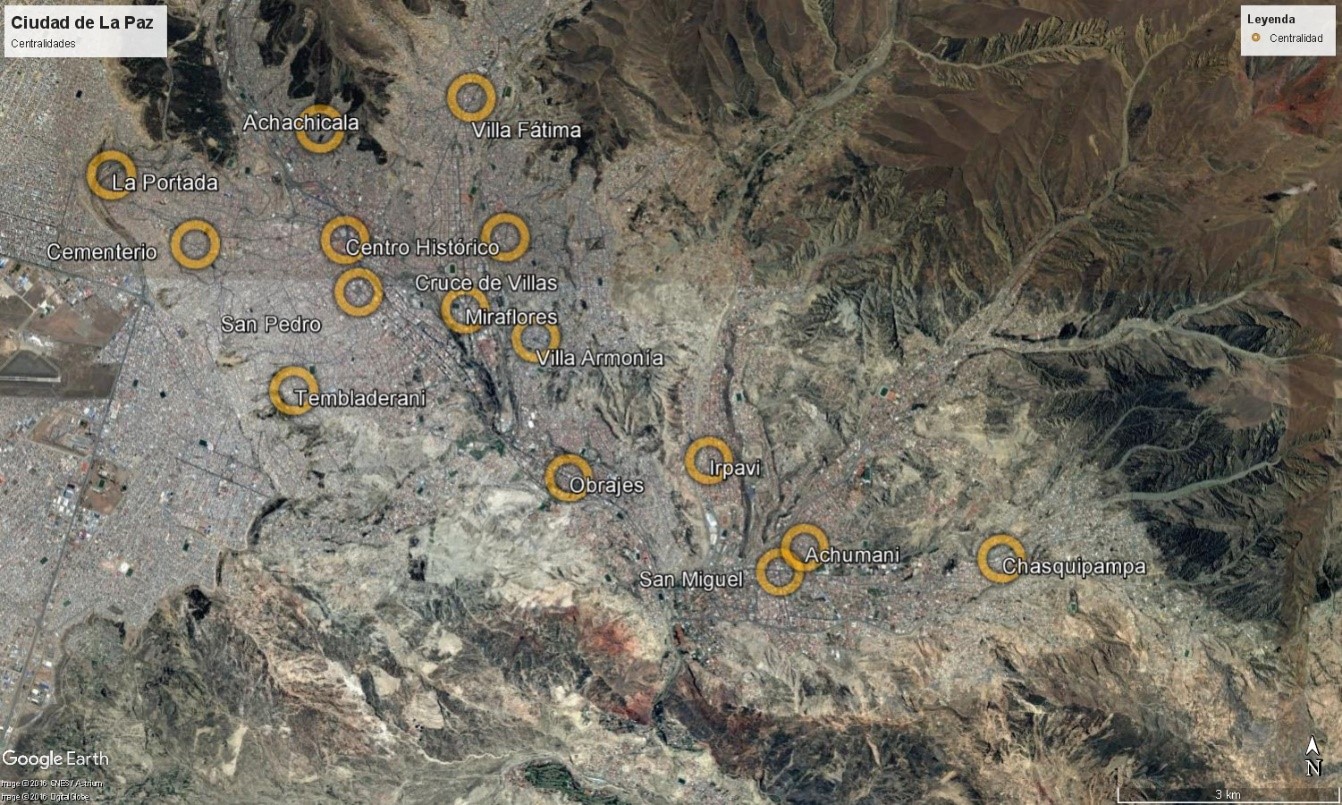
13 of La Paz’s 19 centralities (author’s diagram)
In 2001, the city created the “Las Cebras” mobility program, following the implementation of the “ Plan de tráfico, transporte y vialidad para La Paz ” (traffic, transportation and road plan for La Paz). The transportation plan, which gave birth to Las Cebras, aims to reduce mobility issues and pollution, and to improve the quality of life of citizens. La Paz decided to copy Bogota’s successful urban experiment using clowns and mimes as part of an urban animation program. However, it chose zebras instead as its theme, to echo the color and pattern of the pedestrian crosswalks designed to facilitate urban traffic for both pedestrians and drivers in the chaos of downtown (Lanza 2015).
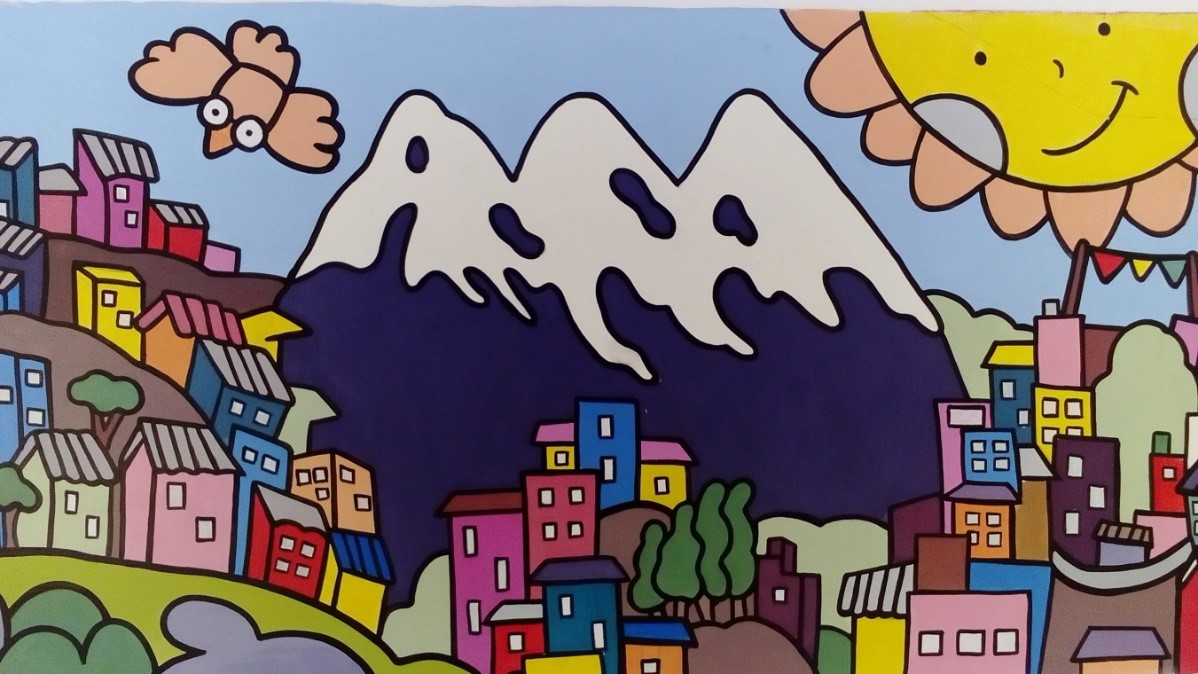
An iconic representation of the city of La Paz. Pipiripi Museum, La Paz. (Photo: Patricia Alvarez)
Before considering the Las Cebras program in greater detail, we will take a short stroll through the streets of La Paz. One immediately becomes immersed in the ambiance of the city, which, like Havana, Beirut, Doha, Durban, Kuala Lumpur and Vigan, was selected as one of the seven new wonders of the world 1. Moving towards the city center, one discovers the “chaos” that reigns in the streets: vehicle congestion and traffic mayhem give rise to constant tension and turmoil among users of the public space. Pedestrians attempting to cross the street must face the rage of drivers who dominate the roads. Between walking (a risky endeavor in this hostile environment) and taking a minibus (which are constantly delayed by traffic), the choice proves difficult.
On the road, bus and car drivers dominate the visual and sound landscape of urban mobility. The “urban experience” varies greatly depending on whether one is a bus driver or a pedestrian, though both face their own challenges. Minibuses and minivans, the numbers of which are increasing in this highly competitive sector, abound in La Paz. 1983 transport lines including minibuses, trufi 2 (minivans) and taxi-trufi (Lanza 2015) traverse the city center, almost always using the same routes, creating unbearable traffic jams that get worse as the day progresses. Even three lanes are not sufficient because minibuses often pick up and drop off passengers in the middle of the road. Thus, the Cebras’s battleground is pedestrian crosswalks. They fight with drivers in order to allow pedestrians to safely cross at red lights, a constant battle waged with patience and a positive attitude by the young Zebras.
At the corner of an intersection one catches a glimpse of a white and black striped figure dancing, jumping, hugging children and helping elderly people cross the street. The Cebras are transforming the urban atmosphere and making La Paz more livable.
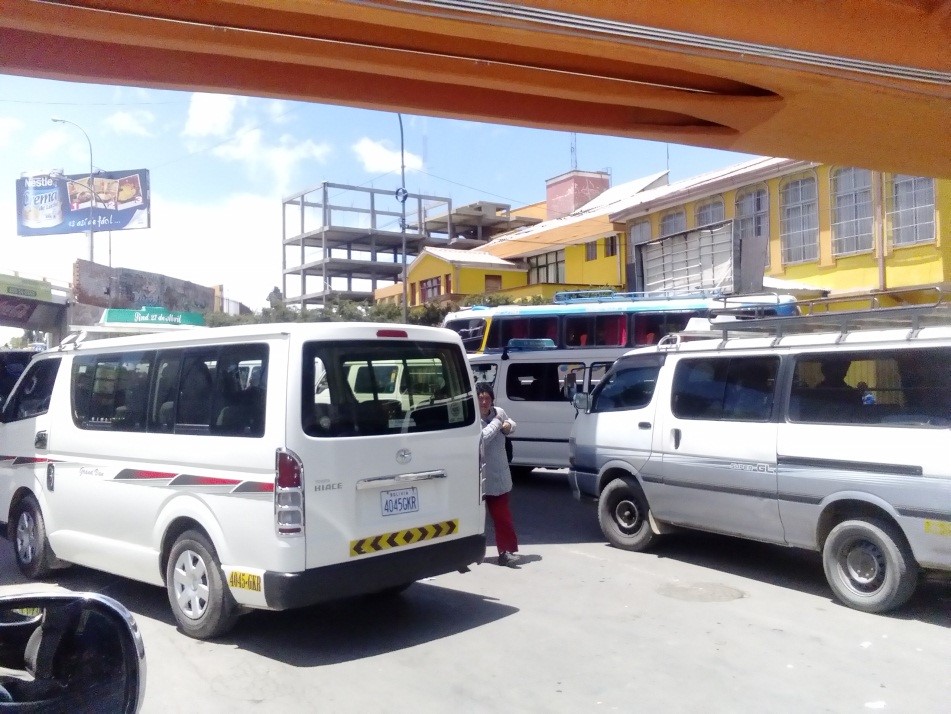
An example of vehicle chaos in La Paz (Photo: Patricia Alvarez)
The Cebras have a strong influence on the city’s inhabitants, and young people in particular. In the urban imagination, they are the authority in matters of traffic and safety as they literally embody citizenship. By creating spaces of dialogue, they improve urban interactions between users, helping them to understand and make better use of the public space. Don José, a driver of a minibus on a line that travels to the city center, remarked that,
"Thanks to these friendly young people, we old people are changing our ways."
The Cebras have a special bond with children, who are the focal point of the program’s strategy. The quadrupeds offer a bit of friendly advice with each hug: "Always cross on striped lines," "Always pay attention to the red light," "Be kind and listen to mom and dad,” etc. For many children, these daily exchanges instill lessons they in turn try to inculcate in their parents, as demonstrated when a four year-old girl told her mother:
"Always cross with the Zebras, Mom. It's the good habit."
If pedestrians used the crosswalks designed for them, it would be a giant step in the right direction in terms of their safety, and a first step in the battle against the hegemony of the automobile.
From its inception, the Cebras program has promoted itself as an opportunity, especially for shoe shiners and young people in precarious situations. The job program has been a great success; it has changed the lives of many young people and created a formal and inclusive labor market. In 2016, the Zebras of La Paz numbered 200 employees, nearly ten times the number at the program’s inception (24 employees). As municipal employees, they are insured and paid in accordance with statutory norms.
The training program has three phases: artistic training, psychosocial training and professionalism in urban entertainment, as well as general training to support other development programs in the city. During urban entertainment training, young people participate in workshops where they are familiarized with the norms and procedures to teach the public. They also learn their responsibilities as Zebras and the program’s code of ethics. The artistic dimension aims to promote the image the characters have forged over time and improve their street performances while strengthening their image as public figures and urban educators. The municipality relies on the "zebra attitude," a communication program that disseminates civic messages to the population through various institutions and activities. The Cebras are trained to dance, to be kind and supportive, to be physically close to people (hugs, etc.) and to provide help to those who need it. Both their body language and their spoken language are intended to have a positive impact. The psychosocial training component is also important, both for the exercise of their function and their own personal needs: they are often young people with difficult backgrounds who are in need of emotional and psychological support. Even though people’s attitudes towards them have changed in recent years, being a Zebra in the city is still a difficult and tiring job.
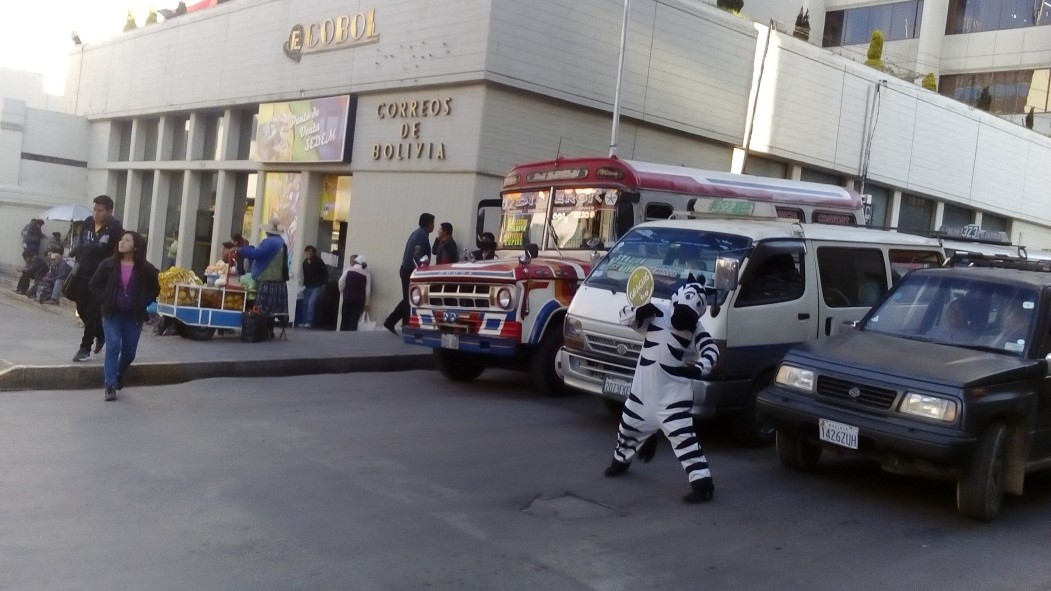
A Zebra in the city center (Photo: Patricia Alvarez)
Fifteen years after a rocky start, the Zebras are now regarded as an institution and have become an icon of friendliness. The program, founded on the precepts of co-responsibility and citizen participation, is La Paz’s key strategy for appropriating public space and exercising citizenship (GAMLP 2015).
The young quadrupeds have no legal authority when it comes to traffic: their job is to collaborate with the traffic police, which is complicated as their relationship with drivers has always been contentious. However, their popularity has made drivers more respectful of regulations. Zebras propose preventive mediation to avoid altercations by appealing to people's consciences.
Unfortunately, it is impossible to measure and/or quantify the Zebras’ impact on people’s habits and ways of living. Traffic accident and incident statistics have been stable over the past decade. However, the data is not considered relative to the increase in the number of vehicles or insurance contracts, which make it possible to better account for accidents than in the past (APS 2010). Despite the government’s and Zebras’ efforts, mobility problems persist and much remains to be accomplished.
The Zebras’ role has gradually diversified. In addition to all the mobility-related issues (noise reduction, respect for pedestrian crosswalks, respect for traffic signals, etc.) (Lanza 2015), they now target three additional areas of action and education as regards civic culture: citizen co-responsibility for urban cleanliness, the monitoring of alcohol consumption and legal custody of and care for pets.

“Thank you!” The words that echo a friendly urban attitude (Photo: Patricia Alvarez)
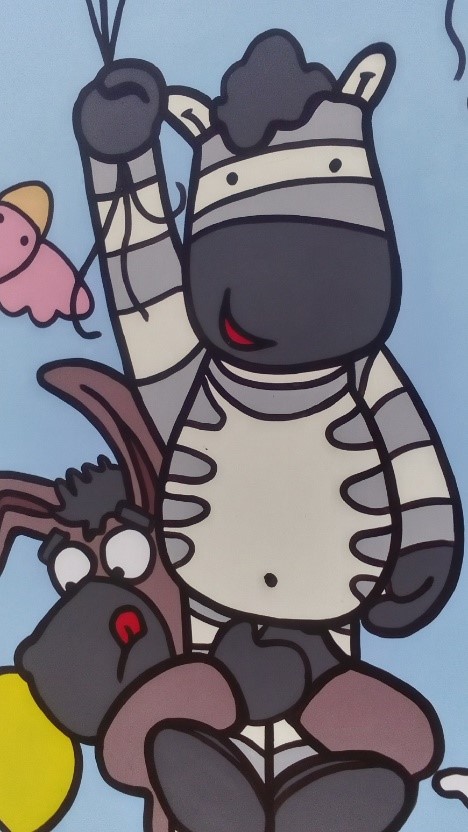
A drawing of a zebra, an icon of friendliness and quality of life in La Paz (photo: Patricia Alvarez)
The Zebras’ role in the public space and in teaching people about more responsible and prudent mobility is indisputable. Today, no one can imagine La Paz without them.
However, this role could be even greater if they contributed to the city's move towards a mobility transition, such as assisting the city in implementing major programs like the "Barrios de Verdad," environmental awareness programs, the mobility and transportation plan (which aims to improve urban transportation service) or the development of alternatives to motorized vehicles. Their constant fight against motorized vehicles is increasingly becoming an apology for active, slow mobility, notably through the valorization of walking trails. The Zebras’ fight against the dominant car model clearly aims to move the city towards a more sustainable model. To do this, La Paz must develop a mobility system that capitalizes on the Zebras’ message, i.e. strengthening the soft mobility network and structuring the public transportation offer, bus stops that correspond to actual uses and not arbitrary stops, etc. The hope is that this will put an end to the untimely and excessive stopping to respond to individual passengers’ demands.
City Hall’s efforts through the Las Cebras program has clearly helped people develop a wide range of mobility skills that the city’s stakeholders must now capitalize on. Unlike earlier generations, one quickly notes that children who have grown up with the Zebras’ influence know the most important safety rules, respect pedestrian crossings and more easily travel by foot in the city. They have a different relationship to the street, the city, the public space and the public good. This must be supported by technical solutions and traffic control systems which, in turn, must be combined with encouraging respect for city life and a social awareness campaign.

Las Cebras are an icon of conviviality for La Paz (Photo: Patricia Alvarez)
Interviews
José Martinez. Driver affiliated with the Nuestra Señora de Copacabana urban transportation union. September 2016.
1 The nomination submitted to the New7wonders Foundation was based on specific characteristics of La Paz, such as altitude, history and the multiculturalism of the city’s inhabitants, from the indigenous peoples living together in La Paz (http://laopinion.com/2014/12/08/la-paz-bolivia-elegida-ciudad-maravilla/).
2 Trufi is the name given to collective mini transport vehicles, be it minivans or cars (taxi-trufi).
For the Mobile Lives Forum, mobility is understood as the process of how individuals travel across distances in order to deploy through time and space the activities that make up their lifestyles. These travel practices are embedded in socio-technical systems, produced by transport and communication industries and techniques, and by normative discourses on these practices, with considerable social, environmental and spatial impacts.
En savoir plus xPolicies

Southern Diaries by Forum Vies Mobiles are licensed under a Creative Commons Attribution-NonCommercial-ShareAlike 3.0 France License.
Permissions beyond the scope of this license may be available at contact.
Other publications